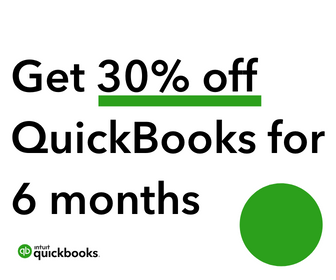Choosing the right eCommerce platform for your online business is never easy. There are so many platforms out there, which one should you choose? In this article, I give you my list of the top 10 best ecommerce platforms on the market. I’ve worked with all of them so have a pretty good idea which one is best.
I want to make this process easier for you by highlighting the best ecommerce software on the market so that you can find a shopping cart solution for your online store. With so many options available, it’s important to pick the solution that’s going to win in the end, so let’s take a look at some of the best solutions available.
What Are the Best Ecommerce Platforms?
Selling online can be a very fulfilling way to make money, but there are many considerations to be made before starting an ecommerce business. Each of the best ecommerce platforms has some incredible features, and choosing the right one for you will depend on a number of factors.
If you want to dropship rather than fulfill orders yourself, for example, you’ll need a system that lets you do that. If you plan to sell three products, the system you choose might differ from the one you’d use if you planned to sell 100 products or more.
Ultimately, ecommerce software should make it easy for you to add products quickly, offer coupons and discounts, and track inventory. It should also help you manage shipping and fulfillment so that you can focus on running your business.
NEXCESS
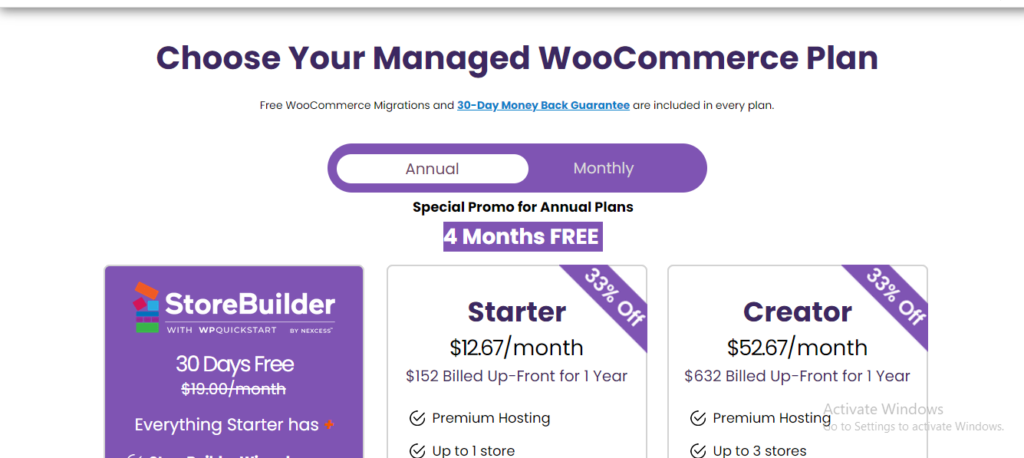
Nexcess is a multiple service provider with hosting options for all your needs. Whether you want fully managed WordPress hosting, Magento hosting, WooCommerce Hosting, or ecommerce platforms like Drupal and BigCommerce, Nexcess has you covered.
You get the following features:
- PHP optimization
- PHP7 support
- 24/7 monitoring and alert response
- Near-instant asset caching
- Container add-ons (additional storage space)
- Single-click auto-scaling to handle an abrupt rise in traffic.
- A built-in CDN with 22 locations.
- PCI compliance.
- Cloud accelerator to speed up load times.
- Customizable technology stack.
- Dev site staging to test updates.
They also help you develop an attractive storefront with their StoreBuilder tool. Provide some information, and the tool will give you a unique storefront.
The WooCommerce hosting comes with all the features you could want, including the ability to add abandoned cart emails, a site builder tool with lots of design options, image compression, and affiliate tracking using the AffiliateWP plugin. The WooCommerce hosting comes with all this as well as integration with Glew.io for advanced analytics.
Read our full Nexcess hosting review here
Plans
- Starter – $19 per month (1 store, 30 GB storage, up to 500 orders per-hour)
- Free trial for 30 days.
- Creator – $79 per month (3 stores, 60 GB storage, up to 1,000 orders per-hour)
- Merchant – $149 per month (5 stores, 100 GB storage, up to 2,500 orders per-hour)
- Standard – $299 per month (10 stores, 300 GB storage, up to 3,000 orders per-hour)
- Growth – $549 per month (20 stores, 500 GB storage, up to 5,000 orders per-hour)
- Enterprise – $999 per month (30 stores, 900 GB storage, up to 10,000 orders per-hour)
BIGCOMMERCE
BigCommerce is the best ecommerce platform for brands that want to sell smaller quantities of more expensive products. Its robust product search engine makes it a good choice for larger retail brands in particular.
This platform is also ideal for people who want to start an ecommerce business, or who already have brick and mortar stores and want to expand their operations beyond. Bigcommerce has many features that make it well-suited for almost any business or niche.
The interface lets you design your store without learning web development by using customizable templates to design your store, sell, and market your products. The templates are aimed at people without a lot of web development skills, but tech-savvy people can tweak the HTML and CSS.
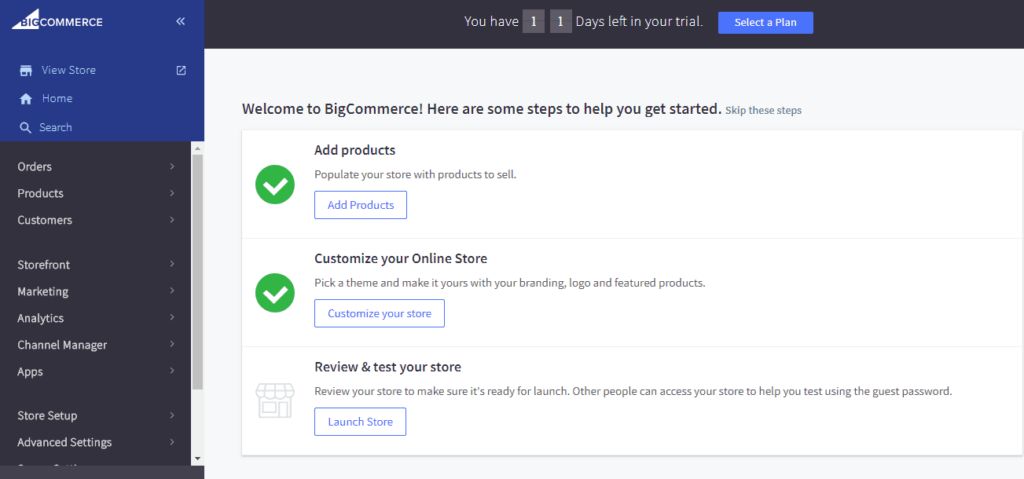
BigCommerce has two product offerings: BigCommerce (their enterprise offering) and BigCommerce Essentials (built for small businesses). Both are integrated with open APIs and have zero transaction fees. They also have thousands of integrations with other services to help you customize your business.
Big Commerce launched BigCommerce for WordPress in December 2018, a new product allowing users to connect their WordPress sites with their ecommerce. The product uses APIs to allow for faster WordPress site speed than you find with other WordPress ecommerce options like WooCommerce, which installs multiple plugins that run separately and slow down page-loading times.
Small businesses can take advantage of BigCommerce’s pricing structure, which ranges from $29 to $399 per month. Unlike some competitors, the platform doesn’t charge to design a website, though some of its tools have higher price points than tools on competitor platforms. Bigcommerce is best suited for enterprise brands looking to leave expensive on-premise solutions like Magento and move their e-commerce operations to software as a service (SaaS). Brands like Ford and Toyota use BigCommerce and can easily bring in over $100 million in annual sales without hiccups.
SQUARE ONLINE
Square’s popular point-of-sale system has launched Square Online, a standalone ecommerce platform for local businesses. It offers a variety of options for local businesses, including curbside pickup and local delivery.
Features:
- Online food ordering for restaurant websites.
- Tools for online and in-person retail.
- Online bookings through Square appointments.
- The ability to accept donations for nonprofit websites.
Square Online offers an affordable, fully-featured e-commerce plan that lets you start selling online today. You get unlimited products and inventory, in-house and on-demand delivery, gift cards and coupons, SEO tools, an SSL certificate, integration with Instagram, inventory sync with Square POS, and more. The only transaction fee you pay is 2.9% + $0.30 (or 1% + $0.30 if paid monthly). One drawback of this plan is that you don’t get to use your own domain name.
Paid plans:
- Professional ($12/month): Custom domain name (free for one year) and no Square branding.
- Performance ($26/month): Adds abandoned cart emails, on-site customer reviews, and discounted shipping labels.
- Premium ($72/month): Lower transaction fees, highest shipping discounts, and a real-time shipping rate calculator.
WOOCOMMERCE
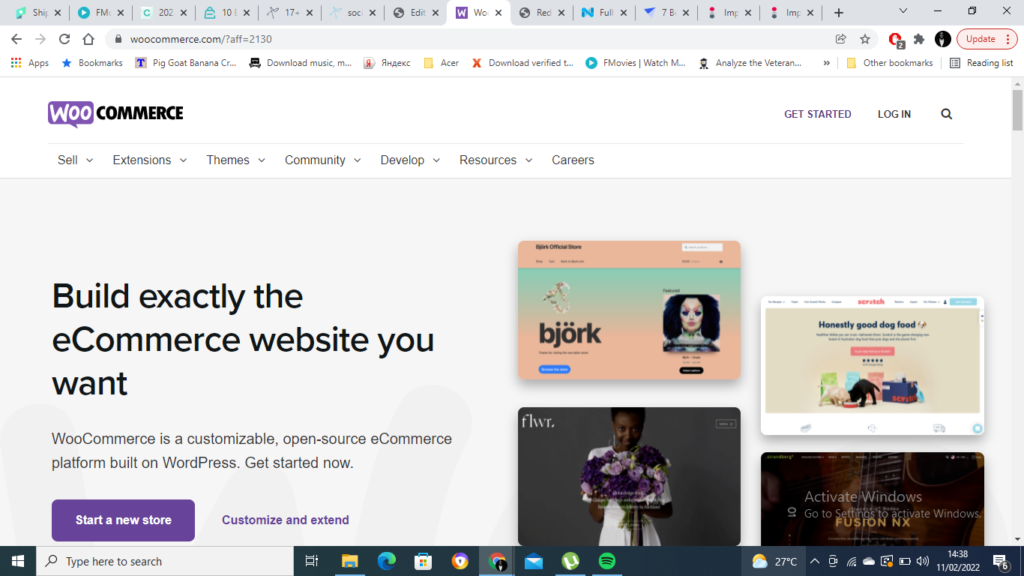
WooCommerce is a WordPress plugin that turns any website into a functional ecommerce store, credit card processing and trust-based payment gateways are integrated, social media integrations are available, email marketing is possible, 1-click selling is offered, and shipping is integrated.
The biggest problem with WooCommerce is that it’s not very scalable in terms of cost and performance. Most users have reported it slowing down as they get more products and customers, and the free themes you can use are limited. Most extensions have prices attached, though some WordPress themes are paid. It follows the WordPress platform, so if you’re familiar with that, WooCommerce is a breeze. You just install it, add your own products and customize its settings.
Nexcess StoreBuilder is a good option if you want to use WooCommerce and also get hosting. We talk about it in more detail in our section on other builders to consider.
Pros
- WordPress is the best platform for SEO
- 1 Click selling app available
- Lots of WordPress experts available
- Highly customizable
- Many marketing options and plenty of other integrations
Cons
- Good hosting can be pricey
- Have to deal with blame game for troubleshooting.
- Virtually zero support
- You need extensions for simple stuff
SHIPBOB FULLFILMENT
ShipBob provides ecommerce fulfillment solutions for entrepreneurs and business owners. If you’re selling physical items, ShipBob can help you get your products to your customers. We make it easy to set up, send out, and track orders.
ShipBob was designed to help companies build stronger relationships with their clients. As a next-day and 2-day delivery provider, ShipBob helps brands drive growth through excellent customer experiences. This means that you don’t have to start from scratch if you already have a website built on Shopify, WooCommerce, BigCommerce, or Magento.
Fetures:
Inventory Management: ShipBob uses a third-party logistics (3PL) software which tracks historical data to gain insights with regards to inventory distribution across warehouses. This helps ShipBob provide faster shipping at lower costs based on where most of its customers are located.
Order Management: ShipBob’s order management system tracks all shipments from receiving, processing, delivery, and returns stages and automatically transfers tracking details to customers. Connect it to your store to send inventory to fulfillment centers close by for processing and storage.
Advanced Reporting
Pros:
- Saves you a lot of time with product fulfillment processes
- Excellent customer service compared to other fulfillment provider options
- Fantastic way to go beyond things like eBay for online selling
- Access to plenty of educated ShipBob employees for additional help
- Good shipping rates that are adjusted to your specific needs
- Lots of cost and location options to choose from, so your business can expand
- Excellent interface that’s easy to navigate when sending WRO orders
Pricing:
- Receiving: $25 for the first two hours, then $35 per man hour for every hour after that.
- Storage: A monthly charge of $40 per month per pallet, or $10 per shelf per month. You can also choose bin storage for $5 per bin per month.
- Pick and pack: This is included in the cost for the first five picks in an order, then it’s $0.20 for the sixth pick and beyond.
- Standard packing: This is included in the box for free plain boxes, tape, mailers, and dunnage. However, you may need to pay more for extra branding.
- Shipping: Specific to your order: This will vary depending on the weight of the product, the dimensions, shipping requirements and so on.
SHOPIFY
Shopify is best known as an ecommerce platform. Their website hosts over 400,000 merchants worldwide. They are a Canadian company that launched in 2004 and became a SaaS powerhouse right away.
Shopify got its start by appealing to the audience of “dreamers”—new users who want to strike it rich in ecommerce. Shopify’s integrations, even for the most inexperienced users, can set up a dropshipping store with relative ease. I tested it out by picking my inventory and integrating a few dropshipping suppliers with Shopify.
However, just because you have a great-looking website that sells products doesn’t mean you will have a successful online store. You will need to market your business if you want people to find you through search engines and purchase from your site.
A few drawbacks of using Shopify are that they enforce SEO rules that can hurt your rankings, as well as force you to use the format for category pages located at campingsite.com/collections instead of enabling you to make the page more keyword-friendly (such as campingsite.com/tents).
BigCommerce has trouble managing an extensive product catalog. If you’re selling t-shirts, for example, and have different colors, materials, and sizes, your SKUs will go through quickly. Shopify allows only 100 product variants – not enough if you have a lot of different product combinations.
Pricing
With its three plans ranging from $29 to $299 and its enterprise Shopify Plus platform offering custom pricing, Shopify works well for both small businesses and large companies.
SELLFY
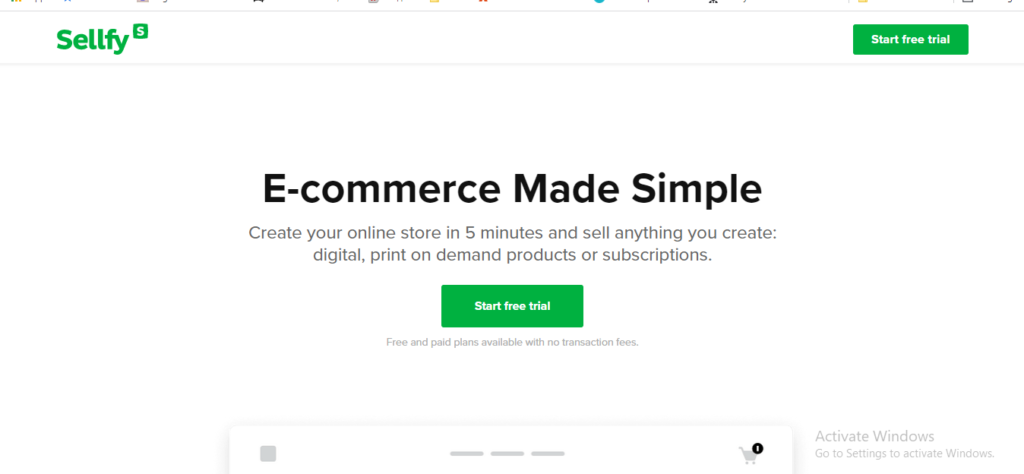
Sellfy was created in 2011 as a way for anyone to create and sell digital products. Over the years, the platform has evolved to let anyone run an online store, regardless of business structure or product type. It’s a quick and easy platform that requires no technical know-how to start using.
How it works:
- Connect your Sellfy store to your existing website
- Attach your store to a custom domain
- Use “Buy Now “and other embed options to make sales from other platforms.
Sellfy’s pricing plans are pretty straightforward, but you can customize your plan to save some money. With a free plan that includes up to 10 products and no custom domain, you can get started on a shoestring budget.
Premium plans are affordable compared to other ecommerce platforms, and the range of features included in the standard plan makes it an even better value. If you want to sell more than 10 products or use a custom domain, upgrades will be necessary.
However, if you do so in the early days when you’re just getting off the ground, you can scale up at your own pace and grow with your business.
Sellfy starts at $29/month, and its most expensive plan is $159/month before year-end discounts. With the ecommerce platform, you can easily sell your products online. Compared to other platforms such as Shopify—which offers less features than Sellfy in its most affordable plan—you can save a lot of money. However, you’ll have to purchase additional apps such as Recurly to enable recurring billing for subscriptions
Sellfy lets you create a Shopify-powered online store in just five minutes. The Free plan lets you sell more than a dozen products and nearly 50 photos, while the Pro plan allows unlimited products, digital products, subscriptions, and lets you use Sellfy’s own print-on-demand platform to sell as many POD products as you want.
SQUARESPACE
Here is another platform that offers drag-and-drop customization. Squarespace was founded in 2003, and it offers sleek templates for business websites, ecommerce stores, and blogs.
You can start selling with Shopify for as little as $18/month when you get started on the Business plan. You can save 3% on transaction fees by getting started at a higher price point. The top pricing tier, Unlimited, lets you sell subscriptions and gift cards, and gives you flexible discounting options.
In order to sell you must sign up for the basic store selling plan which is a monthly fee of $18 if you pay annually. This plan has its limitations: you will have to pay 3% on transaction fees. There are ecommerce plans that range between $26 and $40 per month. The best option for your business is the top ecommerce plan because it allows you to give flexible discounts and offer subscription services to your customers.
The store builder comes with the basic features you’ll need to get started, like a customizable home page and an easy way to import products from your existing ecommerce site. The drag and drop editor isn’t as great as Weebly’s but you’ll get the hang of it after playing around with it a few times.
A built-in social selling feature is great for building a network of customers and influencers who will help you spread the word about your new business. Before you know it, you’ll be enjoying access to marketing, inventory, SEO, and analytics tools that will help you manage and grow your business.
ZYRO
Zyro is a web design company that just released its long-awaited ecommerce platform. Tightly integrated with Zyro’s existing website builder, their new online store builder takes all of the great features they’ve developed over the years as a website builder and adds a full suite of ecommerce features.
This platform thrives in a few key areas First, they allow merchants to sell products across multiple channels including Amazon, Facebook, and Instagram. They also provide easy-to-use features like a drag and drop website builder and an easy set up process that takes just minutes.
Since they are still a relatively new platform, Zyro’s team is still developing advanced functionality and certain features. Currently, there are 68 ecommerce themes from which you can choose. I also spoke with the team, and they promise to have over 150 new themes soon.
SHOPBASE
ShopBase launched in June 2019 as a white-label service, meaning they provide customizable storefronts. This is a great choice if you’re going to white-label your products, offering the perfect mobile-optimized storefronts powered by their team of experts. You can edit every page’s HTML and CSS.
You can personalize your checkout page with your logo, color scheme and any other marketing assets you want to show off. They also offer abandoned cart recovery emails to help increase your ecommerce conversion rates.
What Are Ecommerce Platforms?
Ecommerce platforms are applications that help business owners sell their products and services online. Ecommerce technology has a long history. In the past, companies have purchased costly software that requires technical setup and in-house hosting. Nowadays, individuals can build storefronts online with ecommerce software as a service.
Ecommerce platforms let you sell products easily and effortlessly. They handle everything from web design and product listings to shipping, taxes, and marketing. Within these tools, you can add your own products, manage inventory and orders, communicate with customers, sync with other apps, and more.
Best Ecommerce Platform For Dropshipping
When you’re dropshipping, you don’t control a lot of things. You can’t guarantee the quality of the product or how many returns you might get. There are also technical challenges that you need to overcome to keep your orders moving along as quickly as possible if you want to dominate your market for a given product.
- SHOPIFY
- BIGCOMMERCE
How to choose an Ecommerce Platform.
You have to consider the following factors:
Customer Support
Customer experience influences companies’ annual revenue. This is one of the most telling indicators of a strong business model. Even if you’re using a pre-designed template to build your website, you might run into an issue every now and then.
Website speed and error issues occur, no matter what ecommerce platform you utilize. However, Bigcommerce offers 24/7 chat, email, and US-based phone support to help resolve such technical issues.
Easy Scalability.
If your retail business is traditional and physical, it will be difficult to reach a large audience. For example, if you run a shop that sells high-end women’s shoes, it will be hard to reach customers in the Midwest who like your shoes if you only have one brick-and-mortar store in Southern California.
It’s not very easy to do that if you run a small or medium-sized business, since it is exceptionally expensive. However, you can use ecommerce platforms and expand to reach a global audience and scale up to many times your original size.
You can create an online store on platforms like Shopify or BigCommerce for between $15 and $50 per month, with the most common price being around $30. With your online store, you have the option to set up shop essentially anywhere on the web, not just in a specific neighborhood or area. This broader reach will enhance sales over time, increasing profitability in the long run.
Here are three reasons why it makes sense to market your business on social media.
(1) More than 3 billion people use social media.
(2) Consumers are increasingly open to buying products through social media sites.
(3) Ecommerce platforms easily integrate with social media, so you can sell your wares wherever your audience is.
SEO
To optimize your presence on search engines, most e-commerce platforms provide basic to advanced features. These features enhance your visibility and help manage sitemaps, meta titles, descriptions and more.
When you use WooCommerce with Nexcess hosting, you can also rely on its integration with some of the best SEO-related WordPress plugins to help optimize your website to appear higher in search engines.
Ecommerce Marketing Tools
Social media integration is a useful way to reach your target audience, but it isn’t enough on its own. You need to use other tools as well. After your website is up and running, think about how you can get your customers to buy the things they want.
Ecommerce platforms help you achieve these goals by giving you numerous in-built marketing tools that allow you to track a variety of metrics, including the number of sales and your average order value.
Executive Summary.
That concludes my top ten list of the best eCommerce platforms,
Leave a comment below about other ecommerce platforms you would like to recommend.


